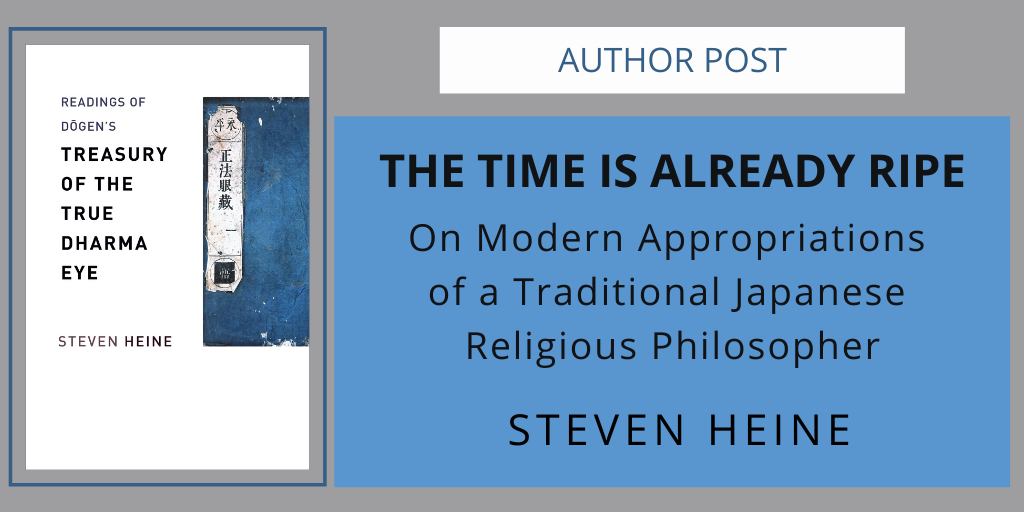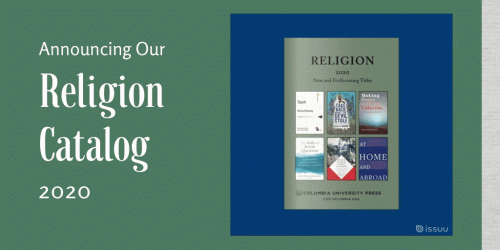“The time is already ripe”: On Modern Appropriations of a Traditional Japanese Religious Philosopher
By Steven Heine

“Vigorous and insightful, Readings of Dōgen’s “Treasury of the True Dharma Eye” provides a deep inspection of central themes in Dōgen’s vast literary legacy. In a clear and inspiring manner, Heine’s analysis sheds crucial light that clarifies both the beauty and the complexity of this giant Zen Master.”
~Eitan Bolokan, Tel Aviv University
Our feature on Readings of Dōgen’s “Treasury of the True Dharma Eye” continues today with a guest post by the book’s author, Steven Heine, in which he discusses the history and cultural context of Dōgen’s treatise as well as the essays and the structure of the book.
Remember to enter this week’s drawing for a chance to win a copy of Readings of Dōgen’s “Treasury of the True Dharma Eye”!
• • • • • •
An ancient Buddhist proverb reads, “When the time is ripe, enlightenment will be attained.” But according to the radical interpretation of this saying by the Zen master Dōgen (1250-1253), founder of the Sōtō Zen sect in medieval Japan, “The time is already ripe, so enlightenment occurs right now.” The rhetorical sleight of hand in transforming the long-standing expression emphasizing potentiality was created by virtue of a syntactical reassignment of the Sino-Japanese characters used in the original sentence. This deceptively simple discursive flourish enables the meaning to accord with Dōgen’s complex view suggesting that, while living amid the everyday world characterized by incessant change and unsettling flux, an authentic Zen practitioner must be able to seize each and every moment as an opportunity to actualize the true reality of the universal Buddha nature. “Not a moment is to be spent idly in twenty-four hours!” is an injunction that further reflects Dōgen’s focus on the unremitting dedication and determination to maintain discipline required of spiritual seekers. He suggests, “Negotiating life and death is the great matter of our being,” yet we must become aware that “Time does not fly like an arrow” or in linear fashion.
Dōgen’s premodern carpe diem standpoint, enunciated so compellingly in his masterwork titled Treasury of the True Dharma Eye (Japanese: Shōbōgenzō), including chapters called “Being-Time,” “Realization Here and Now,” and “Total Activity,” has found tremendous resonance with contemporary worldviews that are based on attitudes toward interpreting time and temporality, or finitude and contingency. These novel understandings, all focused on the dynamic presence of existence rather than eternity, range from the existential phenomenology of Martin Heidegger’s Being and Time and quantum mechanics represented in Albert Einstein’s notion of spacetime to the literary modernism of James Joyce’s ruminations on epiphany in Dubliners and the Beat cadences of Jack Kerouac’s On the Road.
The Treasury of the True Dharma Eye has long been recognized as a masterpiece of East Asian philosophy. It integrates in thought-provoking ways Chinese Zen sources, which Dōgen learned during a four-year pilgrimage to the continent in the 1220s, with Japanese vernacular grammatical constructions and pronunciations. Since being introduced to the English-speaking world about a half-century ago, the Treasury has been gaining increasing international acclaim for its innovative approach to expressing the Zen view of mystical awakening. The past few decades have seen an impressive flow of translations and scholarly studies produced by specialists and comparative scholars, in addition to numerous publications geared primarily to the interests of Zen practitioners. Some chapters of the Treasury have been translated over a dozen times, and several prominent monographs analyze their meaning in great depth and detail.
“However, despite this widespread attention and acclaim, Dōgen’s text remains particularly difficult to comprehend and is subject to diverse and sometimes conflicting interpretations.”
One of the main aims of this new volume, which is part of a series on classical Buddhist literature, is to show that the Treasury is now appreciated perhaps as much as any other work in the history of Asian religions. However, despite this widespread attention and acclaim, Dōgen’s text remains particularly difficult to comprehend and is subject to diverse and sometimes conflicting interpretations. One of the main translators, Gudō Wafu Nishijima, confesses in Understanding the Shōbōgenzō, “The first time that I picked up a copy, I found that I could not understand any of it, although I was reading a book written in my native language.” This is a common reaction, he points out, because “Dōgen wrote using many phrases and quotations from Chinese Buddhism which are relatively unknown to the layman, and difficult to render into other languages.”
The Treasury consists of a lengthy series of erudite essays and insightful sermons on diverse topics regarding Buddhist doctrine and clerical behavior, produced by Dōgen over the course of a couple of decades after he returned to Japan in 1227 from his trip to study Zen. The passage cited above regarding momentary time is one of many intriguing examples in which Dōgen challenges standpoints that tend to deemphasize the role of language for seeming to represent distractions that invariably detract from the quest to attain awakening. His focus on the utility of various types of expression for spiritual attainment is illustrated by instances of purposely puzzling sayings that reflect a fundamentally paradoxical view of reality. The maxims include:
“To study the way is to study the self, and to study the self is to forget the self.”
“Life is a continuous mistake, or a series of misunderstandings one after another.”
“‘Mountains are mountains’ does not mean ‘mountains are mountains,’ yet it does.”
“Only the painting of a rice cake can satisfy one’s hunger; no other remedy applies.”
These cryptic yet illuminating adages demonstrate the distinctive discursive style found throughout the Treasury. All highlight difficulties and challenges to overcoming delusion and ignorance by showing that nearly anywhere one turns can reveal a sense of being trapped by partial perspectives, misleading assumptions, circular thinking, uncertainty, deception, or blunder. Yet each of the dictums, if properly understood, also discloses a contrary standpoint in that Dōgen’s approach to realizing enlightenment surpasses illusion by embracing the comprehensive unity of all forms of existence as well as endless variability perpetually manifested in everyday life.
That enigmatic view can be summed up by paraphrasing some of Dōgen’s main ideas as, “Reality is one, but as soon as you try to explain a particular thing, any utterance appears at first to be limitlessly misguided. However, from within such a series of errors and fragmentations, a genuine understanding of the wholeness of true reality can instantaneously emerge, even though an expression of this level of insight still needs to be continually clarified and modified depending on particular pedagogical circumstances.” Carrying out that ongoing interpretative task requires an innovative way with words chosen carefully to articulate the fundamental contradictions embedded in human experience and lead from misunderstanding to genuine awareness.
“The Treasury frequently uses creative allusions and metaphorical expressions involving ingenious puns in addition to purposeful grammatical distortions of both Chinese and Japanese sources.”
The effect of Dōgen’s standpoint based on imaginative interpretations of Chinese writings deliberately bewilders his reader so as to shift drastically their mode of thinking from everyday reason to the wisdom of nonthinking, which is unbound by the rules of logic yet can operate freely in terms of rationality when that level of discourse is appropriate to the pedagogical needs of a disciple. The Treasury frequently uses creative allusions and metaphorical expressions involving ingenious puns in addition to purposeful grammatical distortions of both Chinese and Japanese sources. These unusual rhetorical methods uncover the normally concealed levels of spiritual significance underlying experience even—or especially—when this stance upsets and inverts the typical sense of words and phrases. To cite a Chinese Zen saying that epitomizes Dōgen’s outlook, a genuine teacher should try to startle his audience by “overturning the great ocean, kicking over Mount Sumeru [a mythical cosmic peak], scattering the white clouds with shouts, and breaking up empty space; straightaway, with one device or one object, he cuts off the tongues of everyone on earth!”
Therefore, the time is already ripe for reading and appropriating Dōgen’s Treasury of the True Dharma Eye from contemporary perspectives since its philosophy, based on achieving self-realization right now, seems to be needed more than ever.







